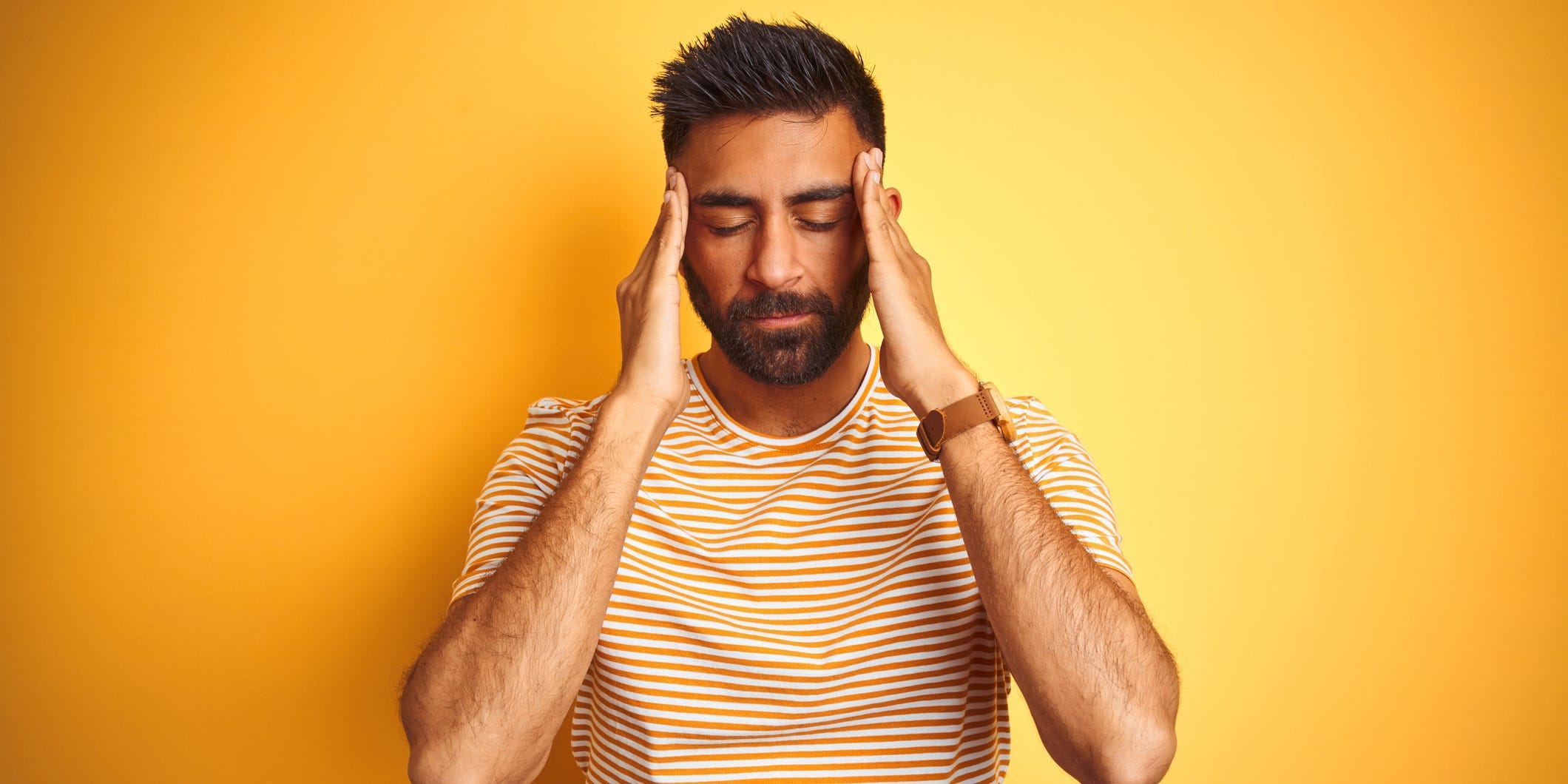
AaronAmat/Getty images
- Dehydration headache pain is located on both sides of the head and causes a throbbing sensation.
- Dehydration causes headaches because blood vessels in the brain temporarily shrink.
- To treat a dehydration headache, drink water, rest, and take an OTC pain reliever.
- Visit Insider's Health Reference library for more advice.
A headache is a common symptom of dehydration, but did you know why?
Turns out, when you're dehydrated, the loss of fluids causes blood vessels in your brain to temporarily shrink which can trigger a headache.
While a dehydration headache isn't a medical emergency in and of itself, it is a sign that you're dehydrated, which, if left untreated can increase your risk of more serious conditions like heat illness, UTIs, and seizures.
Here is what you need to know when it comes to dehydration headaches from how to treat one to prevent it from recurring.
What does a dehydration headache feel like?
Everyone's experience is different, but often dehydration headaches feel like a throbbing sensation on both sides of the head, says Bradley J Uren, MD, an associate professor in the Department of Emergency Medicine at Michigan Medicine.
This differs from the pain of other headaches like:
- Sinus or congestion headaches, which often cause pressure or facial pain in your cheeks and forehead.
- Tension headaches, which feels like a tight band around your head
- Migraines, which cause pulsing pain on one side of the head or around the eyes.
Another way to know if it's a dehydration headache is to check for other symptoms, such as:
- Fatigue
- Dry mouth
- Confusion or delirium
- Constipation
- Dizziness or light-headedness
- Thirst
What causes a dehydration headache?
Your body is made up of 55% to 78% water, making it an essential part of what keeps you functioning. Throughout the day, we lose water through urination and sweat and gain water from drinking and eating. But, sometimes our bodies lose more fluid than we take in. This causes dehydration, which takes a hit on your entire body.
In particular, dehydration causes the brain to slightly shrink, most likely due to blood vessels shrinking. When this happens, it can lead to discomfort and result in a headache, says Uren.
Dehydration headaches can be brought on from mild, moderate, or severe dehydration, but it often depends on the person.
You will be at a greater risk for dehydration in cases such as:
- Vomiting or diarrhea, such as from food poisoning or the flu
- Physical activity and sweat loss
- Heat and increased exposure to the sun
How to treat a dehydration headache
Dehydration headaches will vary in length depending on the individual, but research has found that, depending on how much you drink, the headache can be resolved within 30 minutes to three hours. Here are four steps to follow in order to treat a dehydration headache:
1. Drink water: The number one way to treat a dehydration headache is to drink more water, says Grace Fjeldberg, RDN, a nutritionist at Mayo Clinic. A 2004 study found participants who drank at least 500 mL to 1000 mL of water felt relief from their headache within 30 minutes and their headache resolved after one to three hours.
2. Drink electrolytes: Electrolytes are essential minerals such as sodium and potassium that we lose through sweat. If you are an endurance athlete or someone who works outdoors in the heat, drinking beverages with electrolytes, such as Gatorade or Powerade, may help resolve dehydration symptoms. However, also drink water, which is more important for hydration than electrolytes alone.
That's because most people consume enough electrolytes in their daily diet, says Fjeldberg.
3. Take OTC pain relievers: Taking medicine such as Ibuprofen or Tylenol can help with a headache, but Fjeldberg says this will not manage the problem in the long run. Hydration should be the first course of action.
4. Rest: If you are feeling a dehydration headache on a hot day, Uren suggests finding a shady or cool spot to rest and drink water until you feel able to continue exercising or other activities.
How to prevent a dehydration headache
The only way to prevent a dehydration headache is to stay adequately hydrated, which means getting 15.5 cups of fluids per day for men and 11.5 cups of fluids for women.
This can include water, but also other beverages, such as fruit juices or tea, and meals. In fact, one fifth of our daily fluid intake is from water-rich foods like celery or yogurt.
Insider's takeaway
Headaches are a common symptom of being dehydrated. Normally, a dehydration headache is a bilateral throbbing sensation and may feel worse during activity or in certain positions. You may also feel fatigue, dry mouth, and confusion.
Drinking water is the best way to treat a headache from dehydration, but it's also a good idea to rest and seek shade until you feel better. If you have trouble staying hydrated throughout the day, keeping a reusable water bottle with you or adding flavor to your water are great ways to stave off any dehydration symptoms.